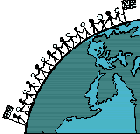|
|
|
|

|
 |
 |
 |
The Environment |
''Children have the right to grow up in a healthy environment which provides facilities for them to grow and develop'' |
|
Uganda is an entirely land locked territory with its capital city Kampala, situated 2,272 km by rail from the Kenyan coastal port of Mombasa. The neighbouring countries are Sudan in the north, Kenya to the east, Tanzania and Rwanda in the south and Zaire to the west. In size, Uganda is comparable with the United Kingdom and lies astride the Equator. Surprisingly it has a agreeable climate with an average temperature of 73'F (= 23'C)due to the fact that most of the country is on a high plateau (on average 1,220m. above sea level). Uganda covers an area of 238,462 km which includes 39,000
km of swampland and 95,823 km of open water. The highest mountains
reach 4,900m. and the river Nile starts its 3,000 mile journey
from Uganda at the mouth of Lake Victoria. Deforestation is the largest environmental problem facing Uganda today. Scouts in Uganda are very active in trying to protect and preserve the forests of Uganda. They are involved in many tree planting programmes and are encouraged to minimise the use of wood in their Scouting activities. Programme ideas2. How to plant a tree like the Scouts in Uganda |